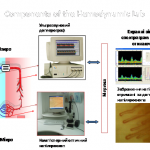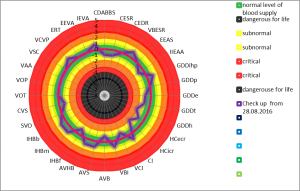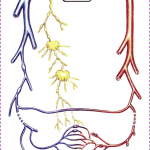Technology of Personalized Treatment “Angiotherapy”
Angiotherapy is a personalized technology for the correction of vascular disorders under the control of evidence-based medicine.
Angiology as a science of the structure and function of the vascular bed has long gone beyond the theoretical modeling of the cardiovascular system. With the advent of in vivo methods of visualizing the function of the vascular bed – namely the quality of blood supply, there is a need to find verification of certain changes in the vascular bed.
Today,  no one denies that the cardiovascular system is the most dynamic system of a living organism, which parameters are constantly changing and require synchronization of all parameters of blood supply (and about 100 in each vessel) and their coordinated work in certain ranges.
no one denies that the cardiovascular system is the most dynamic system of a living organism, which parameters are constantly changing and require synchronization of all parameters of blood supply (and about 100 in each vessel) and their coordinated work in certain ranges.
Adequate blood supply of all organs and systems in different regional vascular reservoirs depends on the coordinated work of all segments of the cardiovascular system at all key levels: heart-main and peripheral arteries – arterioles-capillaries – venules – peripheral and main veins – heart.
That is why we have proposed a model of vascular blood supply that enables to set all the necessary parameters to ensure blood supply in all the most remote segments of vascular blood – at the level of microcirculation.
If the vascular blood supply functions satisfactorily, the level of microcirculation is sufficient for the blood supply of all capillaries, the absence of microthrombosis and perivascular edema. That is why capillaries act as arbiters of well-being in the work of the entire cardiovascular system, just as the village (not the capital) reflects the welfare of the country.
As CVS is a deeply dynamic system, dynamic parameters of changes in blood flow, rather than structural changes, are early signs of vascular dysfunction.
It is the hemodynamic parameters that need to be studied by instrumental ultrasound methods, verification of their functional range and the possibility of using them for mathematical modeling of pathological processes in order to adequately correct them.
Due to the fact that deviations of 1-2 functional parameters of blood flow from 100 available prevail in the early preclinical stages of vascular disorders, it is necessary to determine which parameters need to be corrected.
When there is a clinical picture of vascular disorders 10-30 hemodynamic parameters may deviate from the norm. It also resembles a matrix of a combination of 30 different out of 100 possible parameters that need to be adjusted and bring the vascular blood supply to normal condition.
Such approaches are the basis of individual angiotherapy technology, which aims to detect specific changes in the vascular bed of a particular patient (preclinical abnormalities of hemodynamic parameters may precede the CVD clinical picture by 1-3-5 years). However, early changes are difficult to detect, but easier to treat than long-standing changes that have already turned into uncontrolled paradoxical reactions throughout the blood flow. It is such hemodynamic chaos, when more than 40 parameters get out of control of the dynamic system that leads to critical conditions and cardiovascular catastrophes.
 The personalized angiotherapy involves the formation of a combination of drugs that have a point of application aimed at certain hemodynamic parameters and allow to restore each parameter separately and form a new synchronization of all parameters into a single orchestra, which gives a pure “melody” – adequate blood supply as the most distant link of blood supply and basics of functioning and metabolism in each organ in particular and in the body as a whole.
The personalized angiotherapy involves the formation of a combination of drugs that have a point of application aimed at certain hemodynamic parameters and allow to restore each parameter separately and form a new synchronization of all parameters into a single orchestra, which gives a pure “melody” – adequate blood supply as the most distant link of blood supply and basics of functioning and metabolism in each organ in particular and in the body as a whole.
The competitive advantage of angiotherapy technology:
- Predicted positive treatment result and the possibility of stable stabilization of the cardiovascular system in an adequate range of hemodynamic parameters.
2. The angiotherapy technology is based on the principles of evidence-based medicine: we treat not a general diagnosis, but a specific pathology.
3. Since the angiotherapy technology is focused on objectification of specific pathological parameters of blood flow and has a tool for this objectification – ultrasound technology of angiomarkers and vascular screening technology, monitoring changes in treatment allows for increasing the effectiveness of personalized treatment in 5-7 times better than with standard approaches.
4. Correlation analysis of the dynamics of hemodynamic adjustment enables to visualize the process and understand the vector of these changes – in sanogenic or pathological perspective.





